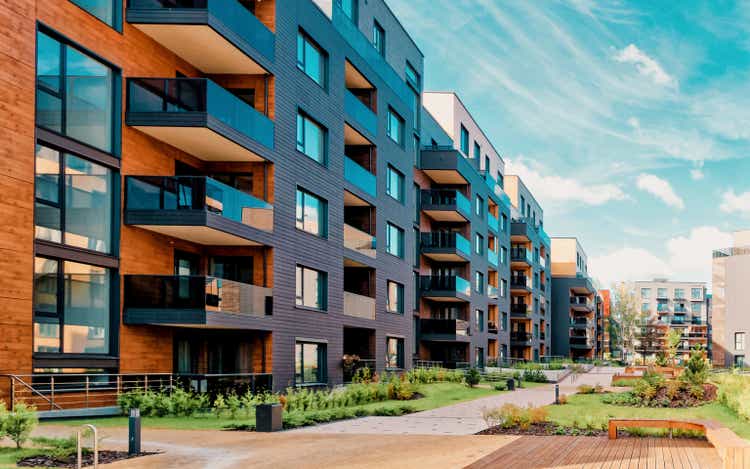RomanBabakin/iStock via Getty Images
With the busy fall conference season now under way, it is typical for publicly traded REITs to provide mid-quarter operating updates (in the form of company presentations, press releases, and 8-K filings) before they go on the road. We’ve had many of our constituent companies in the residential REIT sub-sectors provide updates over the past week. The feedback bodes well for Q3 results, implying a solid close to an impressive 2022.
Equity Residential (EQR) provided a glimpse into July and August operating results, reporting that their blended rental rate growth was 12.8% and 11.8%, respectively, compared to 14.3% in June. Occupancy for July and August ticked down slightly to 96.5% and 96.6%, respectively, from 96.7% in June. The company commented that results are on track to meet or exceed expectations put forth at the end of the second quarter. It also reiterated that rent growth likely peaked in early August and will moderate through the balance of the year, which is normally the case following the busy spring/summer leasing season, and as residents and their families settle back into school/work schedules for the balance of the calendar year. The still vibrant leasing activity and rent growth exhibited by EQR in recent months is an example of the continued strength in their markets.
Essex Property Trust (ESS) provided an update that was not dissimilar to the one articulated by EQR. Its July/August same property revenue growth was a strong 12.4% and in line with the upwardly revised company guidance that was put out at the end of Q2. Its July/August blended lease rates increased 10.3% (year over year), slightly above expectation. The company notes that the moderation in rent growth is primarily a function of more difficult comparisons from the same period in 2021, and not from a material drop-off in current market conditions. Finally, cash delinquencies as a percentage of rent were 0.6% for July/August, which is a solid improvement vs. recent periods.
UDR, Inc. (UDR) highlights the persistently strong operating results in its blended coastal/sunbelt portfolio, stating that market rents continued to increase sequentially in August. It anticipates occupancy for Q3 and the balance of the year will remain exceptionally high, in the range of 96.7%-97%. UDR also expects blended lease rate growth of 13% for Q3 compared to 15.7% in July and 13.5% in August, a moderation in growth driven by seasonality but quite strong none the less. UDR expects operating expense pressure to persist through the balance of the year and trend above 5% in the second half of 2022 as inflationary pressures from utilities, repairs and maintenance, and property taxes remain elevated. The company’s continued optimism can be partially attributed to demand drivers including traffic (physical and virtual), rising income levels, shrinking household sizes and rent-to-income ratios for new residents that are comfortably in the low 20% range.
Sunbelt market bellwethers Mid-America Apartment (MAA) and Camden Property Trust (CPT) continued to turn out strong operating results in the July/August period, but we would note that they have kept full-year guidance numbers consistent with what was reported with Q2 results. MAA disclosed blended lease growth in July and August of 16.5% and 14.1%, respectively, which compares to 17.1% in the first half of 2022. As touched on above, the deceleration in growth is primarily driven by the “base-line effect” of 2021 comparisons much more than any deceleration in demand or deterioration in fundamentals. Full-year net operating income guidance continues at a 15% midpoint and 2022 FFO guidance implies 18% growth over 2021. CPT’s July/August occupancy was maintained at 96.7%, down only 20bps from peak occupancy of 96.9% reported in Q2. Blended lease growth for July and August was a healthy 12%-13%.
In the single-family rental category, both Invitation Homes (INVH) and American Homes 4 Rent (AMH) provided operating updates for July and August. In both instances, blended rent growth has maintained the strong pace that has been exhibited since the start of 2022. INVH’s rent growth was in line with Q2 results at a remarkable 11.8%, while AMH increased lease rate growth modestly to 9.6% in July/August, up from 9.3% in Q2. A consistent theme in the single-family rental sub-sector has been consistently low resident turnover, which has the effect of moderating blended lease growth relative to traditional apartments, as rent growth on renewed leases is typically more modest than rent growth on new leases. Low resident turnover (high retention) is, however, more positive for operating expenses as “turn costs” can be expensive for the landlord and often entail downtime to refresh the unit for new occupants, along with advertising costs and other expenditures. Occupancy levels for both AMH and INVH were down slightly in July/August relative to Q2, but both companies report that occupancy thus far in Q3 is above 97%. So it’s extremely strong going into the quiet leasing season, which typically defines the Q4 period.
In summary, the strength of the late-summer residential leasing season bodes well for our constituent companies as they transition into the quieter part of the leasing calendar. The fact that rents and occupancy levels are strong going into Q4 is especially comforting given the softening economic environment now starting to play out across the U.S., as stubborn inflationary pressures and rising interest rates zap consumer confidence and cause businesses to reassess their growth plans going into 2023. We believe that the residential REITs, many of which should provide initial 2023 earnings guidance in late October and early November, are poised to continue demonstrating consistent and predictable growth in operating cash flow and dividends for 2023 and beyond.


Be the first to comment